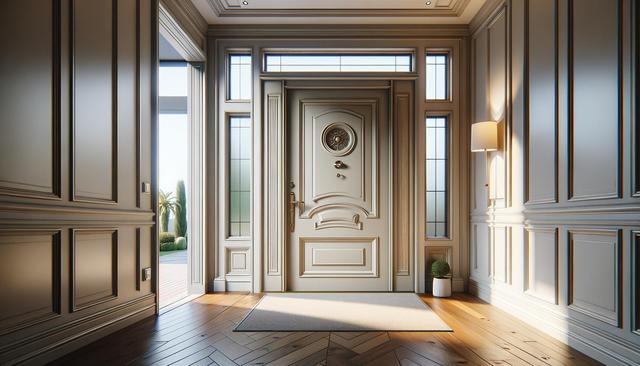Choosing the Right Material for Your Entry Door
The material of your entry door plays a key role in its appearance, durability, and performance. Common materials include wood, steel, and fiberglass, each offering its own benefits. Wood doors are known for their timeless appeal and can be customized with various stains and finishes to match the architectural style of your home. While they may require more maintenance to prevent warping or cracking, they offer a classic and warm appearance that many homeowners appreciate.
Steel doors, on the other hand, are valued for their strength and cost-effectiveness. They provide a higher level of security and are resistant to shrinking or swelling due to weather changes. Fiberglass doors are a versatile option that mimics the look of wood while offering enhanced durability and energy efficiency. These doors are particularly suited for extreme climates, as they resist dents, rust, and corrosion over time.
When choosing a material, consider factors such as your local climate, the level of maintenance you’re comfortable with, and the aesthetic you’re aiming to achieve. A well-chosen material enhances both visual appeal and long-term performance, ensuring your investment stands the test of time.
Enhancing Home Security Through Entry Door Features
Security is one of the most important considerations when selecting a front door for your home. A secure entryway deters intruders and provides peace of mind for your household. Look for doors with solid construction, reinforced frames, and advanced locking systems. Steel and fiberglass doors often outperform traditional wooden doors when it comes to resisting forced entry.
Additional features to consider for improved security include:
- Multi-point locking systems
- Deadbolts with reinforced strike plates
- Peepholes or smart doorbell cameras
- Impact-resistant glass inserts
Moreover, doors with fewer glass panels or those with laminated or double-glazed glass can offer better protection without compromising on style. Installing a quality door also means ensuring proper fitting and professional installation, as gaps or misalignment can undermine the door’s effectiveness in keeping your home secure.
Improving Energy Efficiency with Insulated Entry Doors
Beyond aesthetics and safety, an entry door significantly contributes to your home’s overall energy efficiency. Older doors, especially those with poor insulation or single-pane glass, can be a major source of heat loss or gain. Modern entry doors often come with built-in insulation materials such as polyurethane foam, which helps reduce energy consumption by maintaining indoor temperatures.
Key energy-efficient features to look for include:
- Weatherstripping to seal gaps
- Energy Star certification
- Low-E glass on doors with windows
- Thermal break technology to reduce heat transfer
Choosing an insulated entry door can lead to noticeable savings on heating and cooling bills. It also enhances indoor comfort by reducing drafts and maintaining a consistent temperature throughout the home. This is especially beneficial in regions that experience seasonal extremes.
Style and Design Options to Complement Your Home
Your front door is one of the first things visitors notice, making it a prime opportunity to express your personal style and enhance curb appeal. Whether your home has a traditional, modern, or rustic aesthetic, there is a wide variety of design options available to suit your preferences. Panel configurations, glass inserts, sidelights, and transoms can all be customized to reflect the look and feel you desire.
Common design elements include:
- Decorative glass for added light and sophistication
- Bold colors to make a statement
- Classic wood stains for a timeless appearance
- Minimalist lines for modern homes
Hardware also plays a role in the door’s overall design. Handles, knockers, and hinges can be selected in various finishes to complement your home’s exterior. When chosen thoughtfully, a stylish entry door not only boosts visual appeal but can also increase property value by giving your home a refreshed and inviting look.
Installation and Maintenance Considerations
Proper installation is vital to ensure your entry door performs as intended. A poorly installed door can lead to alignment issues, reduced security, and air leaks that compromise energy efficiency. It’s advisable to hire experienced professionals who can correctly fit and seal the door, ensuring it functions optimally over time.
Maintenance requirements will vary based on the material and finish of your chosen door. For instance:
- Wood doors may need periodic refinishing or repainting
- Steel doors require occasional cleaning and rust prevention
- Fiberglass doors need minimal upkeep and are easy to maintain
Regular inspections can help you spot issues such as worn weatherstripping, loose hardware, or minor surface damage. Addressing these promptly prevents larger problems and extends the life of your entry door. Investing in a quality door and maintaining it properly ensures long-term value, performance, and peace of mind.
Conclusion
Exploring front door options with an eye for style, security, and efficiency can significantly enhance your home’s functionality and appearance. From selecting the right material to incorporating energy-efficient and secure features, every element contributes to a better living environment. A thoughtfully chosen and well-maintained entry door not only protects your family and property but also makes a lasting first impression. Whether you’re renovating or building new, taking the time to choose a high-quality entry door is a smart, enduring investment.




Leave a Reply